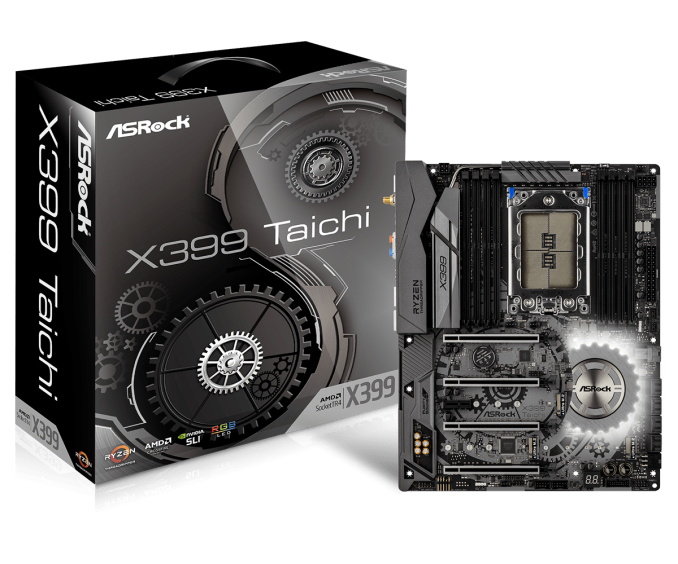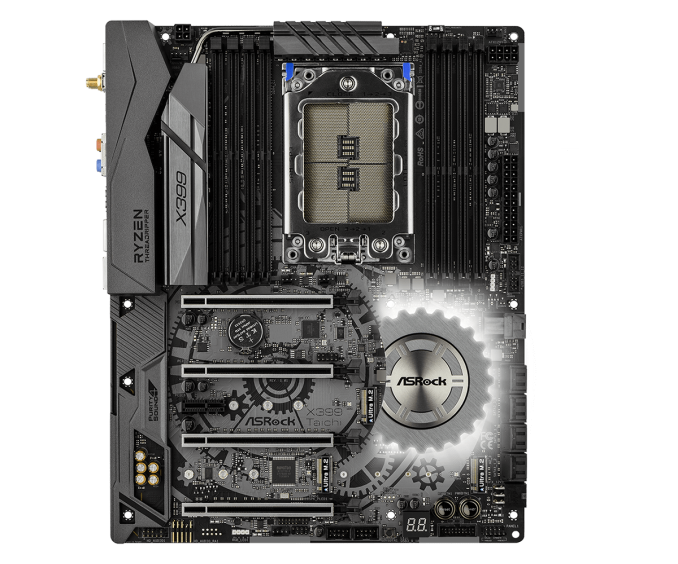An AMD Threadripper X399 Motherboard Overview: A Quick Look at Seven Products
by Ian Cutress & Joe Shields on September 15, 2017 9:00 AM ESTASRock X399 Taichi
The X399 Taichi is configured at a lower point down the ASRock product stack from the Professional Gaming. The Taichi forgoes 10 Gigabit Ethernet, and instead of the Creative Sound Blaster Cinema 3 suite for audio the Taichi uses Purity Sound 4 and a Realtek ALC1220 Codec.
Normally we associate ASRock’s Taichi models with black and white, but this time ASRock has made the board white and grey and drawing attention to the fact that the LEDs can be white if needed. So this means the X399 Taichi has a black PCB with gray accents in the shape of cogs on the PCB area between the PCIe slots and around the chipset heatsink. The DRAM slots are black, while the dual heatsinks for the VRM stretch around to the rear IO via a heatpipe are gray. Much like the Professional Gaming, the only integrated RGB LEDs are under the chipset heatsink, although there are two RGB LED headers for connecting additional RGB strips, all of which can all be controlled by the RGB LED application bundled with the board.
Just like the Professional Gaming, the Taichi supports up to 4-Way SLI and 4-Way Crossfire, with the PCIe slots reinforced using ASRock’s ‘Steel Slot’ protection. From top to bottom, the PCIe slots offer x16/x8/x16/x8 connectivity, taking 48 of the 60 PCIe lanes from the chipset. The final twelve are dedicated to storage with three onboard PCIe 3.0 x4 M.2 slots, one of which is switched with a U.2 connector. Other storage connectivity comes from eight SATA ports, supporting RAID 0/1/10.
The X399 Taichi uses two Intel I211AT gigabit Ethernet controllers, as well as an Intel 3168 1x1 802.11ac WiFi module.
In an almost copy-paste of the Pro Gaming, the Taichi uses the same digital 11 phase IR solution, along with the same EPS placement on the board. USB connectivity on the Taichi is the same as well, with three USB 3.1 (10 Gbps) Type-A ports on the rear panel, one USB 3.1 (5 Gbps) Type-C port on the rear panel, two onboard USB 3.1 (5 Gbps) headers for the front panel, and two USB 2.0 headers as well.
| ASRock X399 Taichi | |
| Warranty Period | 3 Years |
| Product Page | Link |
| Price | $339.99 |
| Size | ATX |
| CPU Interface | TR4 |
| Chipset | AMD X399 |
| Memory Slots (DDR4) | Eight DDR4 Slots, up to 3600 MT/s Supporting 128GB Quad Channel |
| Network Connectivity | 2 x Intel I211AT GbE |
| Wireless Network | 802.11 ab/g/n/ac Dual-Band (2.4/5 GHz) Bluetooth 4.2 |
| Onboard Audio | Realtek ALC1220 |
| PCIe Slots | 4 x PCIe 3.0 (x16/x8/x16/x8) from CPU 1 x PCIe 2.0 x1 from Chipset |
| Onboard SATA | 8x Supporting RAID 0/1/5/10 |
| Onboard SATA Express | None |
| Onboard M.2 | 3 x PCIe 3.0 x4 - NVMe or SATA |
| Onboard U.2 | 1 x PCIe 3.0 x4 (disables M2_1 when in use) |
| USB 3.1 | 1 x Type-A, 1 x Type-C (Rear Panel) |
| USB 3.0 | 8 x Rear Panel, 4x via internal headers |
| USB 2.0 | 4 x via internal headers |
| Power Connectors | 1 x 24-pin ATX 1 x 8-pin CPU |
| Fan Headers | 1 x CPU (4-pin) 1 x CPU Opt/Water Pump (4-pin) 2 x Chassis (4-pin) 1 x Chassis Opt/Water Pump (4-pin) |
| IO Panel | 2 x Antenna Ports 1 x PS/2 Mouse/Keyboard Port 1 x Optical SPDIF Out Port 1 x USB 3.1 Type-A Port 1 x USB 3.1 Type-C Port 8 x USB 3.0 Ports 4 x USB 3.0 Ports 2 x RJ-45 LAN Ports w/ LED 1 x BIOS Flashback Switch HD Audio Jacks |















99 Comments
View All Comments
Vorl - Friday, September 15, 2017 - link
Heads up, the X399 Taichi product link is linked to the pro gaming motherboard link.milkod2001 - Friday, September 15, 2017 - link
Grossly overpriced boards. Cay they drop this LED nonsense & ugly plastics and make proper boards at reasonable $250?DanNeely - Friday, September 15, 2017 - link
The RGB cancer isn't why these boards are so expensive. It's stupid, but only adds a few dollars to the cost; not a few hundred.It's all the extra PCB layers they need to support the 4000 connections to the CPU socket and route all the extra PCIe lanes. Limiting the number of PCIe lanes in mainstream chips is as much about being able to use smaller sockets and fewer PCB layers to keep board costs down as it is a desire on AMD and Intel's part to upsell to X299/X399 systems. The fact that the mobo vendors are probably expecting to sell dozens of mainstream boards for every one of these halo products doesn't help either because it means that the R&D costs can't be spread anywhere near as widely.
For the two boards that have them, the $100 for a 10GB NIC doesn't help any.
tamalero - Sunday, September 17, 2017 - link
Still annoying and useless. They just wanted to appeal the extra gaming segment when this entire system is not for gaming.Now add the fact that almost every goddarn high end videocard AND memory now have shitty RGB lights as well.
Its a waste of power.
CheapSushi - Sunday, September 17, 2017 - link
Are you assuming enthusiasts are all just gamers? You can be an enthusiast that loves gaming AND content creation. If you want no-nonsense then maybe go EPYC instead (YES, it is a workstation platform too, not just server): http://b2b.gigabyte.com/Server-Motherboard/MZ31-AR...mapesdhs - Tuesday, September 19, 2017 - link
Amazing how many people just assume that a PC user is either a gamer or not a gamer. There's a lot of crossover with content creation these days, and also people who stream. Being able to play a game, record the gameplay, convert a previous session and upload it to YT/etc. will be a boon for those who make a living doing such things.CheapSushi - Sunday, September 17, 2017 - link
Finally a voice of reason for the naggers.ddarko - Friday, September 15, 2017 - link
Anyone interested in pairing the Asus Zenith Extreme with the Threadripper version of the Noctua NH-U14S should note that the cooler blocks the first PCI-E x16 slot on the board. Noctua says Asus didn't follow the AMD clearance guidance on this board; you can see in the pic that the top slot is very very close to the CPU bracket.glennst43 - Friday, September 15, 2017 - link
NH-U12S TR4-SP3 will fit though: http://noctua.at/en/nh-u12s-tr4-sp3/specification. I read a German article that showed that this cooler provides very similar cooling perf and noise as compared to the 14S. I have 2 other systems that use variations of the 14s, and I can not find any noticeable noise difference. Still an unfortunate design decision from Asus.DanNeely - Friday, September 15, 2017 - link
Other than the MSI board, I notice that none of them are putting USB2 ports on the back panel. Does that mean the interference problems that some USB2 devices encountered in 3.0 ports have been fixed; or that the mobo makers just feel anyone who needs them can use an IO bracket attached to an onboard header?